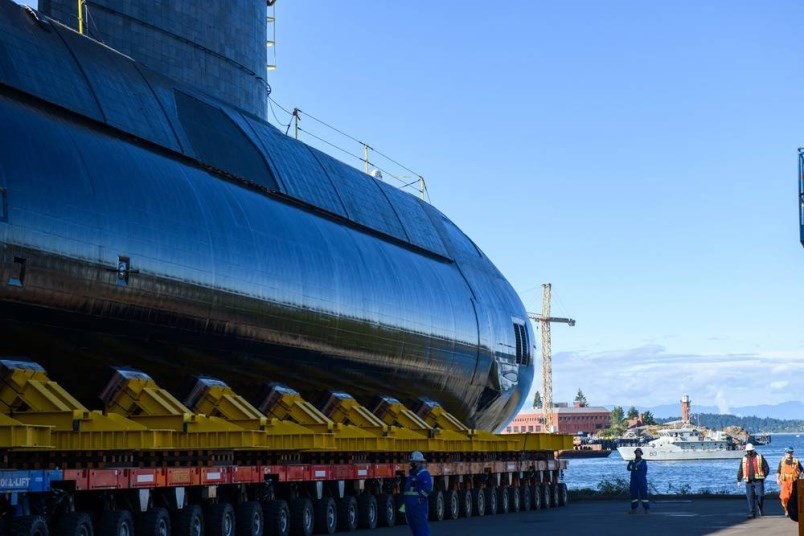Developing a long-term vision for a long-term shipbuilding industry is the task B.C.’s NDP government has set for an advisory committee, the minister in charge said September 22.
“A comprehensive shipbuilding strategy will allow B.C. to take full advantage of our coastal strengths and build a healthier, more sustainable marine economy,” Minister of Jobs, Economic Recovery and Innovation Ravi Kahlon said. “The B.C. Shipbuilding Advisory Committee will help ensure our industrial marine sector is a global leader and poised for long-term growth that is innovative and inclusive.”
Kahlon added that bolstering the 130-year-old industry could move B.C. away from situations where it has to buy ships for the province’s ferry fleet from foreign companies.
British Columbians in August were again questioning the province’s ship purchasing choices as BC Ferries’ fifth Island Class vessel departed the Romanian shipyard where it was built, headed for B.C. via the Panama Canal.
Netherlands-based Damen Shipyards Group was awarded the $86.5 million contract to build the first two vessels in June 2017.
Kahlon said BC Ferry Services’ board chair Brenda Eaton will head one of two groups on the advisory work.
“We wanted to ensure they had a seat at the table,” Kahlon said. “When ships are built overseas and brought home, there’s a lot of frustration from the public.”
Kahlon said B.C.’s shipbuilding strategy will have four main objectives:
•building and supporting the capacity and competitiveness of B.C. shipyards to win more shipbuilding contracts and refit-repair and maintenance work;
•advancing innovation that includes low-carbon technologies to help B.C. become a hub of green, low-carbon marine vessels;
•expanding B.C.’s market share and opportunities related to shipbuilding and supply chains; and
•supporting marine workforce development, addressing labour shortages, equity and inclusion in the B.C. shipbuilding industry.
The last point will mean co-operation between various ministries, including energy, education and advanced education, Kahlon said.
He added that B.C .’s industrial marine sector is made up of more than 1,000 companies engaged in shipbuilding, refit, repair, maintenance and supply-chain activities. This growing sector, driven by shipbuilding contracts such as Seaspan Shipyards’ federal polar icebreaker project, contributes $1.4 billion to the province’s GDP and directly supports more than 11,950 jobs.
That North Vancouver project is one of two, the other icebreaker contract having gone to Quebec-based Chantier Davie. One polar icebreaker was originally budgeted at $721 million and later, in 2013, estimated at $1.3 billion.
In 2019, Seaspan Victoria Shipyards’ received a half-share of a $1 billion federal maintenance program for Canada’s 12 Halifax-class frigates. The ships were first launched in the 1990s and are considered the workhorses of the Royal Canadian Navy.
Victoria’s Esquimalt Graving Dock is the largest ship maintenance facility of its kind in the Pacific Northwest, accommodating a wide variety of vessels, including cruise ships more than 300 metres long.
Kahlon said Port Alberni has also expressed interest in developing that industry on its waterfront.
The 20-member committee’s task is to recommend strategic actions for government and industry to support shipbuilding, ship repair and related marine industries.
The committee is composed of two separate organizations: the BC Shipbuilding Industry Working Group and the BC Shipbuilding Innovation Advisory Council.
The first is chaired by Robert Allan, president of the Association of BC Marine Industries, and is made up of long-standing shipbuilding experts with knowledge and insight that will inform the work of the strategy.
Eaton chairs the second organization, which is expected to provide high-level guidance and objective feedback to the industry group as well as advise on engagement and consultation with stakeholders. It includes senior representation from the B.C. and federal governments, labour and academia.
“BC Ferries keenly understands the importance of a thriving, innovative industrial marine sector,” Eaton said. “This sector not only provides critical support for the maintenance and operations of BC Ferries’ fleet, but it also creates jobs for British Columbians and makes a significant contribution to our economy.”
The committee’s final report and recommendations are due to be delivered to the B.C. government in summer 2022.
The industrial marine sector contributes about $2.4 billion annually to B.C.’s economy and employs approximately 22,000 people.
Victoria supports the sector through workforce development, technology investment and industrial development as well as through the B.C. Shipbuilding and Ship Repair Industry Tax Credit for eligible companies that employ apprentices in the shipbuilding and repair industry.





